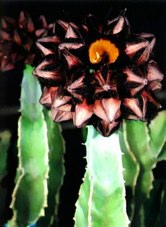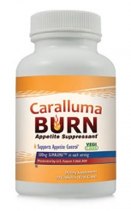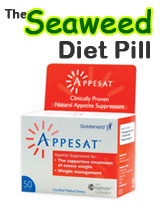The Anti-Obesity Effect Of Caralluma Burn – A Clinical Study
By Matt Denos, PhD
 Caralluma Burn is an appetite suppressant that is based on the edible cactus Caralluma fimbriata. This succulent plant belongs in the family of Apocynaceae, a group of flowering plants that are found in tropical and subtropical climates and include species such as the wildly popular Hoodia gordonii.
Caralluma Burn is an appetite suppressant that is based on the edible cactus Caralluma fimbriata. This succulent plant belongs in the family of Apocynaceae, a group of flowering plants that are found in tropical and subtropical climates and include species such as the wildly popular Hoodia gordonii.
Caralluma fimbriata grows typically in India. As part of the native Indian diet it is eaten either preserved or raw as a vegetable. It is known as “famine food” because it has been used for centuries as a hunger suppressant and thirst quencher.
With obesity rates reaching epidemic proportions, herbs with appetite suppressant effects used by native people are likely to be useful in weight loss and control. The need for scientific evaluation of these herbs becomes apparent in the light of results of carefully conducted objective measurements, which show that energy intake is increased in obese people. Appetite plays an important role in weight reduction.
Read The Caralluma Burn Review
Does Caralluma Work For Weight Loss?
 Dr Rebecca Kuriyan and her research group at St. John’s National Academy of Health Sciences in Bangalore, India, conducted the first controlled study that examined the satiety effect of Caralluma fimbriata in 2007.
Dr Rebecca Kuriyan and her research group at St. John’s National Academy of Health Sciences in Bangalore, India, conducted the first controlled study that examined the satiety effect of Caralluma fimbriata in 2007.
The results, published in the peer-reviewed journal of Appetite, showed that extract from Caralluma appears to suppress appetite and reduce waist circumference when compared to placebo over a 2 month period.
Buy Caralluma Burn From Slimming.com
The study recruited 62 overweight (BMI> 25 kg/m2) but otherwise healthy volunteers aged 28-53 years who were randomly assigned into two groups:
- the experimental group (Caralluma group), which was administered two capsules a day, each containing 500 mg of Caralluma extract, obtained from the aerial parts of the plant, and
- the placebo group which consumed capsules containing maltodextrin, an inactive starch sugar.
The participants visited the clinic weekly during the 60-day course of the study to report their body weight and have a number of anthropometric and biochemical measurements taken, such as waist and hip circumference, skinfold thickness, body density, blood glucose, and lipid profile. At the beginning of the study, the values of al these parameters (baseline values) were similar to both groups. Further, the physical activity was similar for both groups and was kept constant during the study.
Body Weight Assessment
During the study period, the experimental group presented decreases in body weight, BMI, waist and hip circumferences compared to the baseline values. Specifically, the Caralluma group lost 2.5% of the initial body in contrast to the placebo group who exhibited a 1.3% body weight reduction. The waist circumference was decreased by 3.1% in the experimental group.
Appetite Assessment
The effect of Caralluma extract on the appetite was evaluated using visual analogue scales. This is an instrument that measures subjective characteristics or attitudes that cannot be directly measured. Visual analogue scales (VAS) consist of a continuous line between two end points that represent the two extremes of a certain statement. Responders specify their level of agreement to that statement by indicating a position along the line.
Using VAS the subjects were able to express the level of “hunger”, “thoughts of food”, “ “urge to eat”, and “fullness of stomach”. No significant differences were observed between the two groups in the change of “thoughts of food”, “feeling of fullness” and “urge to eat”. However, there was a clear effect on the “hunger levels”. Specifically, the mean “hunger levels” of the Caralluma group decreased by 20% after the administration period. The feeling of hunger was significantly lower than those of the placebo group, despite the fact that the mean “hunger levels” tended to be higher at baseline in the Caralluma (experimental) group when compared to the placebo group.
Food Intake
When the intake of food was assessed for the two groups at the end of the study period, the Caralluma group consumed 188 fewer calories a day than the placebo group. This 8% reduction in energy intake reflected the accompanying reduction in specific macronutrients and specific food groups.
Carbohydrates consumption was reduced by 20g (5.2%), fat intake was lowered by 4,7g (8%) and protein ingestion was cut down by 3,6g (5,7%), respectively. In addition, when compared to the baseline, the Caralluma group consumed less cereals, egg and meat products, as well as sugar and sweets. A similar change in eating behavior was not observed in the placebo group.
Biochemical Parameters
Fasting blood sugar, postprandial sugar, total cholesterol, HDL cholesterol, LDL cholesterol and serum triglycerides were measured at 30 and 60 days. There were no significant differences in the change of these biochemical parameters over time between the two groups.
Side Effects
No serious adverse events were observed. A few mild symptoms of the gastrointestinal tract such as constipation, flatulence, and abdominal distention, were reported in 20% of the participants of both the experimental and placebo group and subsided within the first week.
The results of this study suggest that extract from Caralluma fimbriata has a potential appetite suppressing action. This agrees with the anecdotal evidence and traditional wisdom provided by tribal populations in India. While body weight did no change significantly, administration of Caralluma extract resulted in a significant decline in waist circumference and appetite, with minimal adverse reactions.
Caralluma is one of the best weight loss supplements in the market today and its demand has exceeded that for Medifast promotional codes, discount codes for BistroMD and promotional coupons for Nutrisystem diet. Further research is necessary to identify the phytochemical ingredients responsible for the appetite suppressing properties of the plant, Caralluma fimbriata appears a promising weapon against the battle of obesity and the chronic disorders associated with it.
___________________________________________________


